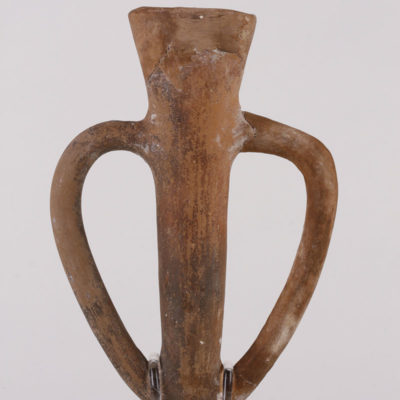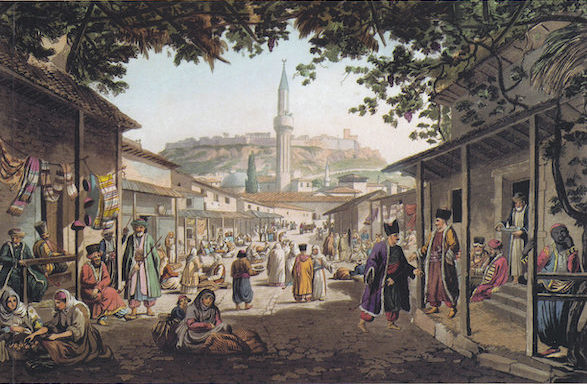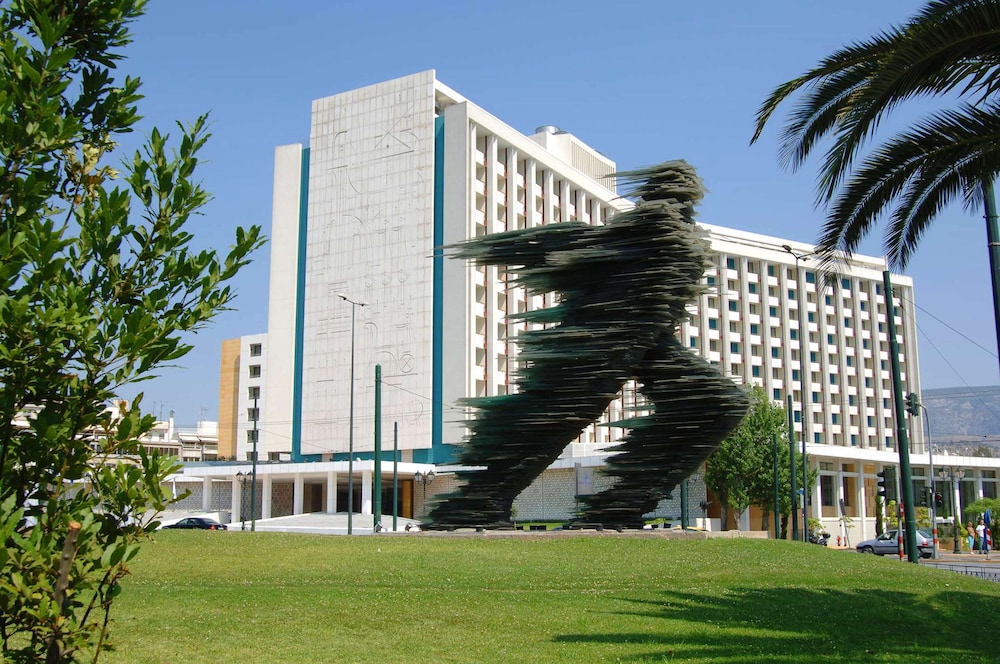
You are using the Free Edition of AthensAPP. For extensive information on Athens, GO PRIME with our comprehensive Greek Travel App featuring the full edition of Athens and 25 Greek islands.

Sometime in the fourth and third millennia BC, Athens began its existence as a Neolithic hill-fort on top of the Acropolis (“high city”). The Acropolis is a natural defensive point that overlooks the plains below. The hamlet was located about 20 kilometers (12 miles) inland from the Saronic Gulf, in the Cephisian Plain, a rich dale bordered by rivers. Mount Hymettus is to the east, and Mount Pentelicus is to the north.
The River Cephisus flowed through Athens in ancient times when it was a component of the city. In comparison to the huge city of modern Athens, ancient Athens comprised a fairly small area. The old city’s walls encircled an area covering about 2 kilometers east to west and somewhat less from north to south, however the city’s suburbs extended well beyond these walls during its peak. The Acropolis was located approximately south of the walled area’s center. The Agora, the city’s commerce and social hub, was located 400 meters (1,312 feet) north of the Acropolis, in what is now the Monastiraki neighborhood. The Pnyx Hill, where the Athenian Assembly gathered, was located near the western extremity of the city.
The Parthenon, or Temple of Athena, which stood atop the Acropolis and whose dramatic remnants can still be seen today, was one of the most prominent religious monuments in ancient Athens. Within the city walls were also the Temple of Hephaestus (which is still mostly intact) and the Temple of Olympian Zeus or Olympeion (formerly Greece’s greatest temple but now in ruins).
According to Greek mythology, the first city of Athens was Phoenician, and Cecrops was the ruler who founded it. On the day the Gods decided to organize a competition to name the developing metropolis after the deity who would bestow the greatest helpful gift upon humanity, the city of Athens was officially formed. As a result, the deity was given the title of patron god of the newly founded city. Poseidon, the god of the sea, and Athena, the goddess of wisdom, were at odds. Athena presented an olive tree as a symbol of peace and wealth, while Poseidon presented a horse as a symbol of might. The settlement was given the name Athena in the end.
Prehistoric Times
The Neolithic period witnessed the first settlers on the Acropolis summit. This rock provided a magnificent vantage point with excellent views to both land and sea, and was thus employed as a military fortress early on. Athens established a Mycenaean city in 1,400 BC, thrived, and eventually became a religious center dedicated to the goddess Athena. From the 12th to the 8th century BC, Greece went through a gloomy period. It is believed that this was the time when king Theseus, a semi-existent and semi-mythical person, ruled the town.
Archaic Times
During these decades, ancient Athens prospered economically, but it lost control of Attica, which was now fragmented into minor kingdoms. In the 7th century, Athens reclaimed control of Attica and gradually established itself as the country’s cultural and artistic hub. Military generals and nobility governed the city for a century. Each citizen’s social standing was determined by his or her riches, which meant that poor people had no rights and slavery was a commodity.
Solon, an Athenian poet and lawmaker in the 8th century BC, paved the way for democracy and ended injustice to the poor by declaring all Athenians (save slaves) equal before the law and abolishing all hereditary titles and privileges. The most powerful Oracle in ancient Greece, the Oracle of Delphi, declared the Acropolis to be the province of the Gods at the same time.
Classical Times
After the Persian Wars (490-479 BC), Ancient Athens rose to prominence as Greece’s most powerful city-state. This is the most prosperous period in Athens’ history. The Classical Century or the Golden Age of Pericles, the man who controlled Athens’ political scene at the period, is known as the 5th century BC. Athens possessed the largest navy in Greece at the time, traded its goods throughout the Mediterranean, and used the Delian League’s Treasury to construct the Acropolis. Pericles’ initiative resulted in the formation of a new government at that time: democracy. Every citizen had the right to speak out in public gatherings and vote on public issues throughout this rule.
Ancient Athens’ economic prosperity produced cultural prosperity. Brilliant thinkers like as Socrates, Plato, and Aristotle developed new philosophical theories, and many sciences and arts flourished. The Ancient Agora was used for political assemblies, and many public structures were built. A new type of art, theatre, was also born, which began as a part of religious events and evolved into a sort of instruction. In fact, the theatre was so important for ancient Athens that by law proposed by Pericles, the state had to pay the tickets for the less-privileged citizens so that every Athenian would attend the theatrical plays.
The decline of classical Athens
After a setback against Sparta during the Peloponnesian War, Athens’ golden period came to an end (431-404 BC). The city of Athens was later ruled by Phillip of Macedon and his son Alexander the Great, but it remained the cultural capital of Greece.
The Romans, whose empire was now governing the Western Mediterranean and progressively pushing east, were the next menace. They finally vanquished the Macedonians after repeated attacks. Ancient Athens did not suffer a lot from the Roman occupation since it was a city admired and respected for her culture, her arts, her philosophy, and literature, hence the Pax Romana that was established.
The peace endured until the Goths invaded Greece in the third century AD. Saint Paul travelled to Greece in 51 AD to offer his famous sermon to an Unknown God, as Christianity expanded over the Empire. In 324 A.D., Emperor Constantine, I relocated the Roman Empire’s capital from Rome to Byzantium and renamed it Constantinople.
Byzantine Times
The Roman Empire was eventually divided into two parts: the Western Roman Empire and the Eastern Byzantine Empire. After years of dominance and luxury, the Roman Empire began to crumble, relinquishing sovereignty to Byzantium, as it does with all empires. At that time, the Parthenon Temple was converted into a church dedicated to Agia Sofia. Until Emperor Justinian abolished the teaching of classical philosophy in 529 AD, Athens remained the epicenter of Greek education and culture. Many western tribes attacked Athens between 1200 and 1459: Franks, Catalans, Florentines, Venetians, and lastly the Ottomans, who ruled for for 400 years.
Ottoman occupation and Independence
The Parthenon was converted into a mosque, and the Acropolis became the Turkish ruler’s headquarters. Following Greek independence in 1821, the city of Athens went through a period of reorganization under the leadership of foreigner King Otto, the new nation’s first monarch. He commissioned his architects to construct majestic Neoclassical structures in the town center, notably his Royal Palace, which currently serves as the home of the Greek Parliament.
A separate military detachment now guards the Parliament and the Presidential Mansion. In fact, hundreds assemble every Sunday morning to observe the ceremonial changing of the guards. A walk around Athens will lead you to several ancient sites and well-known landmarks that are well worth seeing.
Modern Athens
Otto, Prince of Bavaria, was crowned King of Greece in 1832. King Othon, the Greek spelling of his name, as well as Greek national attire, were adopted by him, and he returned Greece’s capital to Athens. As king, Othon’s first responsibility was to conduct a thorough archaeological and topographical study of Athens. He delegated this duty to Gustav Eduard Schaubert and Stamatios Kleanthes. Athens had a population of around 4,000-5,000 people at the time, and was located in what is now the Plaka area of Athens.
Athens was chosen as the Greek capital for historical and sentimental reasons, not because it was a vast city: there are few Byzantine Empire and 18th century buildings in Athens. A new city plan was put out and public buildings were developed once the capital was located there.
The University of Athens (1837), the Old Royal Palace (now the Greek Parliament Building) (1843), the National Garden of Athens (1840), the National Library of Greece (1842), the Greek National Academy (1885), the Zappeion Exhibition Hall (1878), the Old Parliament Building (1858), the New Royal Palace (now the Presidential Palace) (1897), and the Athens Town Hall are among the best examples of this period’s architecture (1874).
Following the devastating war with Turkey in 1921, when more than a million Greek refugees from Asia Minor were relocated in Greece, Athens underwent its first period of exponential expansion. On the outskirts of Athens, suburbs such as Nea Ionia and Nea Smyrni originated as refugee communities.
During World Conflict II, the Germans seized Athens, and the city suffered horrific privations in the final years of the war. Heavy battle erupted in the city in 1944 between Communist forces and royalists backed by the British.
People flocked from villages and islands to find work after WWII, and the city began to expand anew. The city saw a flow of new investment after Greece joined the European Union in 1981, but it also saw an increase in social and environmental problems. Athens experienced some of the world’s worst traffic congestion and pollution. As a result, traffic vibration damaged foundations and air pollution eroded marble, posing a new threat to Athens’ antique monuments. Athens’ failure to secure the 1996 Centennial Olympic Games was primarily due to the city’s environmental and infrastructure issues.
Following that, with the help of European Union subsidies, both the city of Athens and the Greek government embarked on large infrastructure projects such as the new Athens Airport and a new metro system. The city also took steps to reduce air pollution by prohibiting the use of automobiles in the city center. As a result, the 2004 Olympic Games were awarded to Athens..




